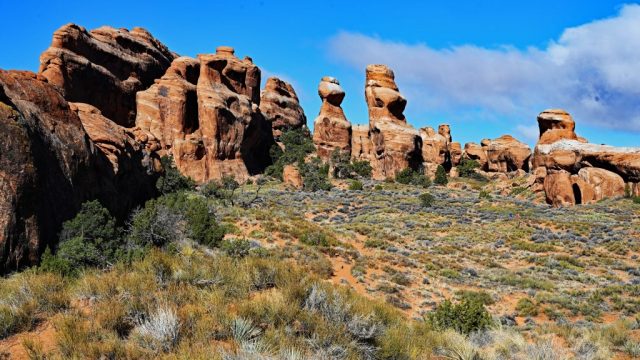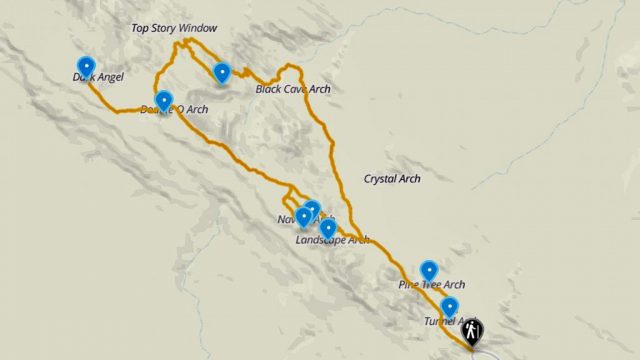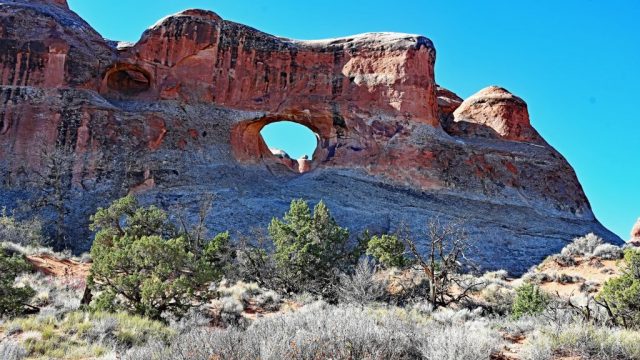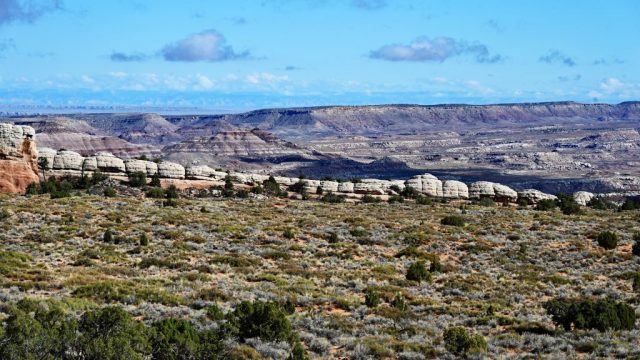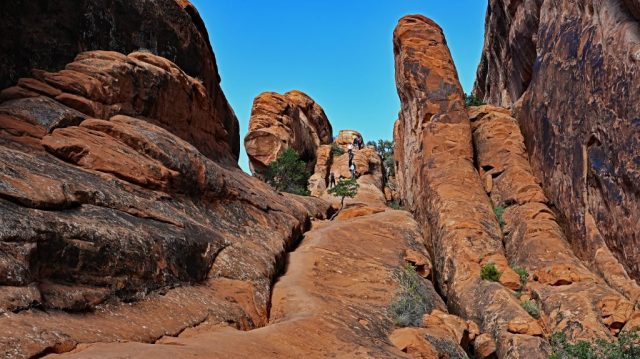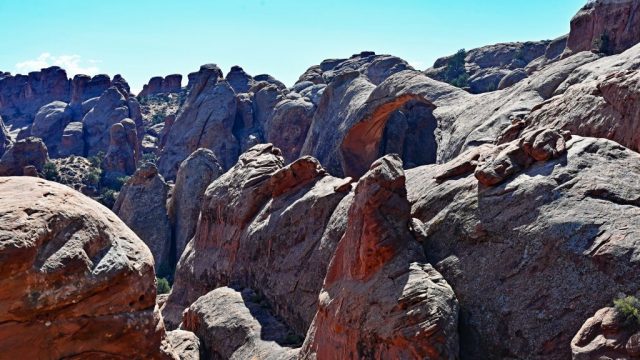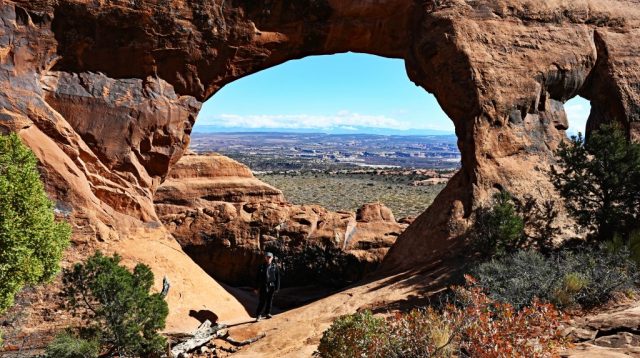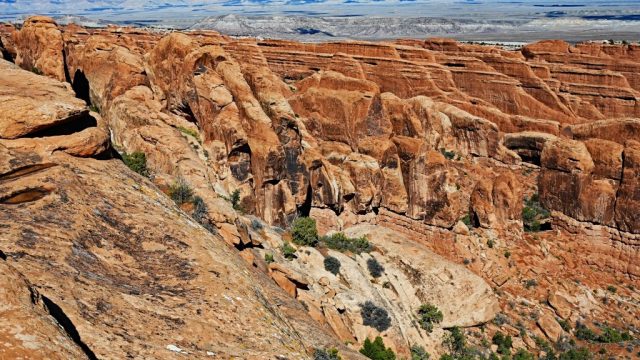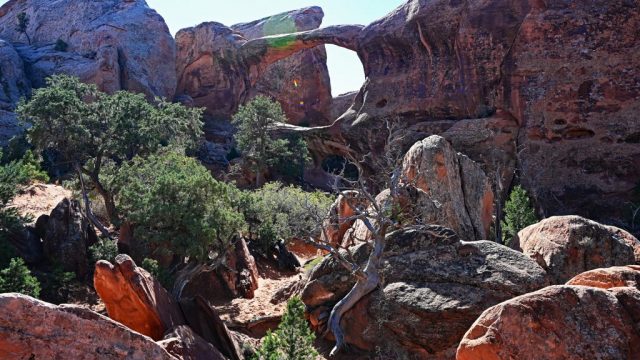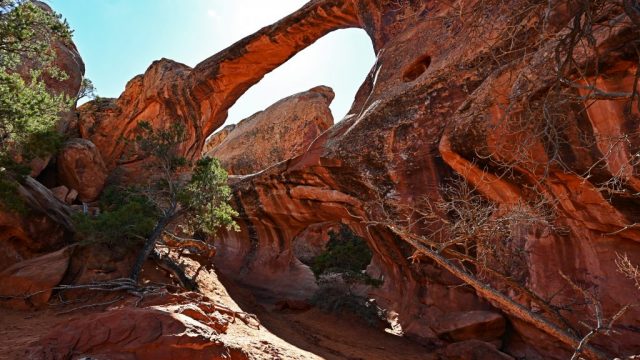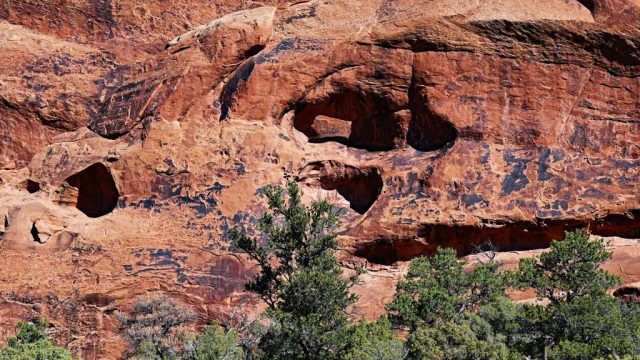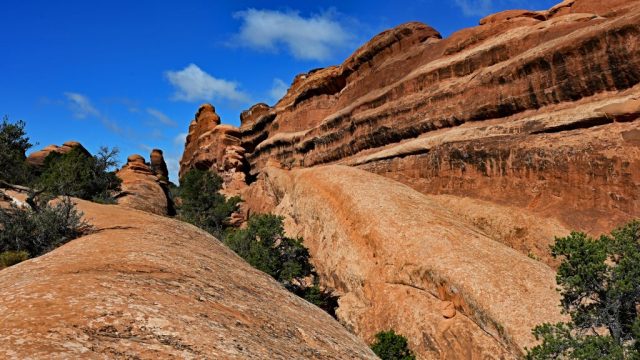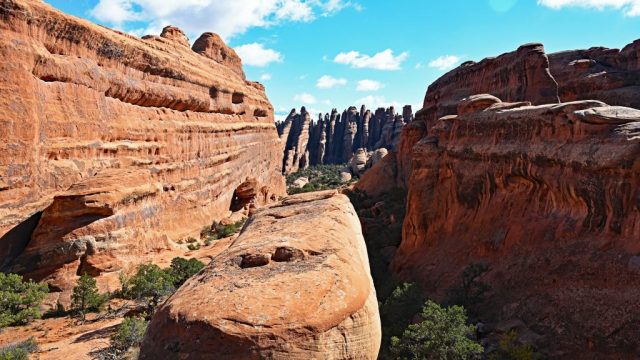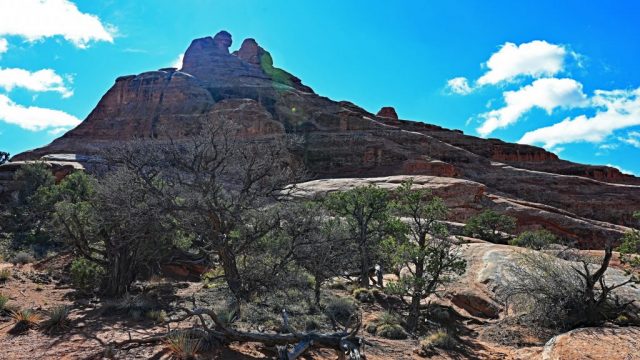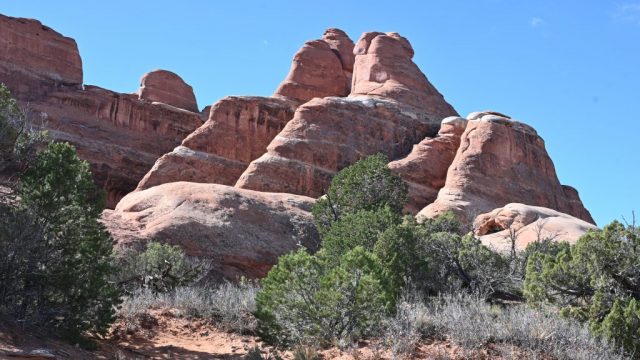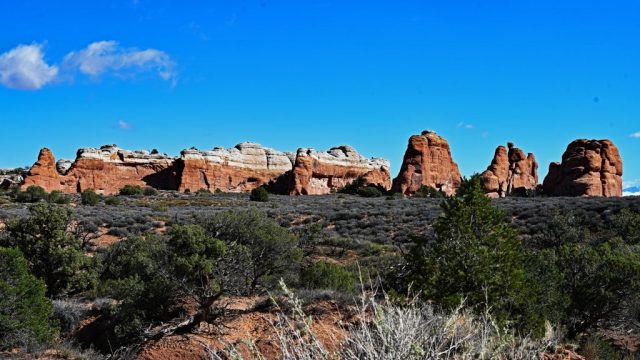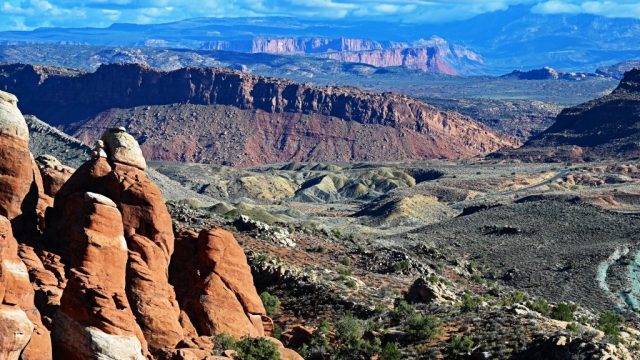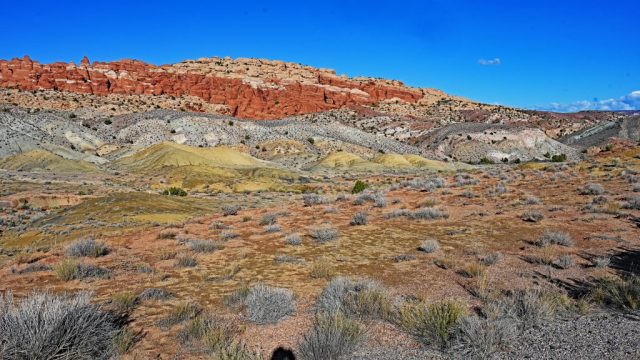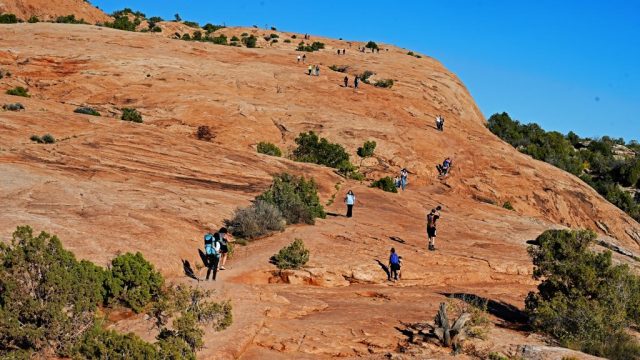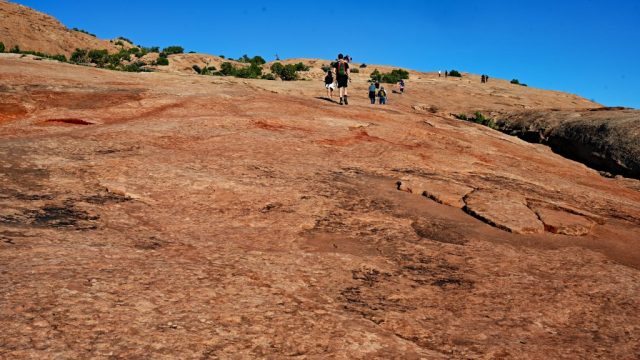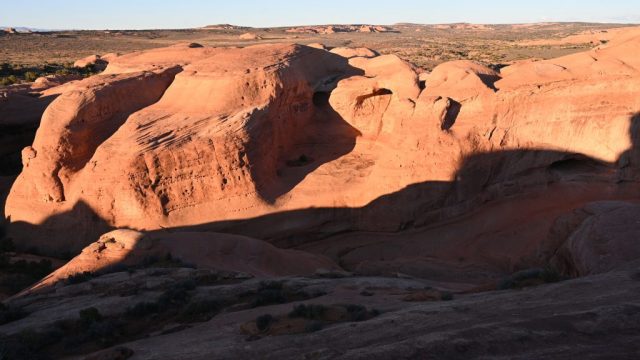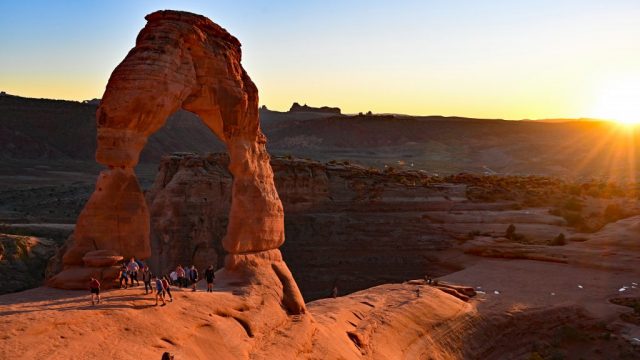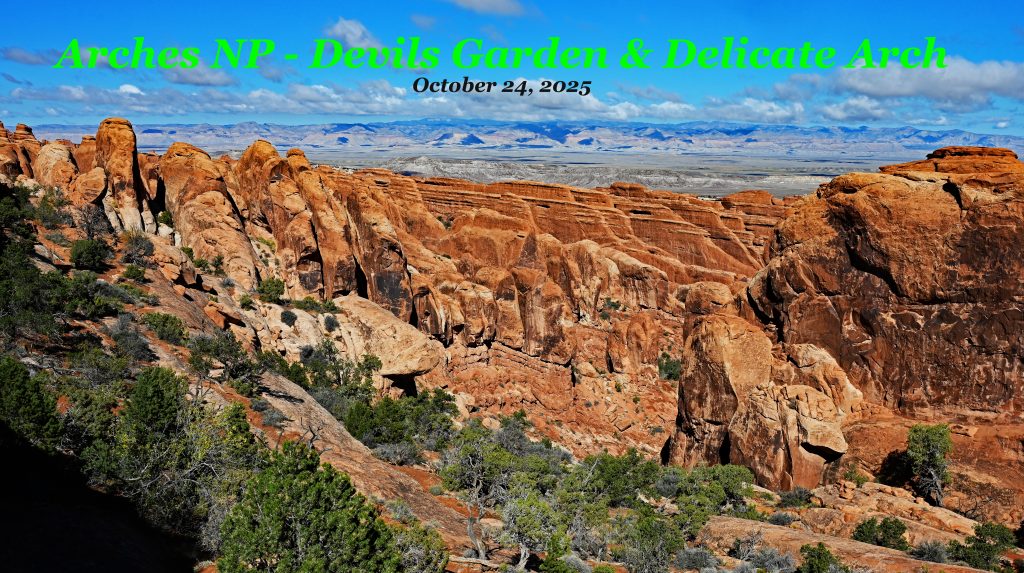
The morning light spread gently across the desert as I drove toward Devils Garden, the farthest reach of Arches National Park. The 18-mile stretch from the visitor center unfolded like a journey through time — layers of ochre, rust, and pale gold rising in sculpted walls on both sides of the road. In the distance, the La Sal Mountains shimmered with a faint blue haze, their snow peaks a cool counterpoint to the heat already stirring from the sand.
When I reached the trailhead, the air was still and dry, filled with the scent of sage and warm dust. The first rays of sunlight slid across the landscape, turning the sandstone to a burnished copper glow. Devils Garden spread before me like an enormous natural amphitheater — a maze of narrow rock walls called “fins,” jagged spires, and curved formations shaped by millennia of rain and wind. They rose in uneven ranks, like petrified waves, each ridge painted in shades of amber, cinnamon, and rose. At the entrance, a labyrinth of rock spires and narrow walls — the “fins” — rose like frozen waves from the earth.
Through the Garden of Stone
The trail began softly, winding through sandy ground scattered with desert shrubs. Not far in, the Tunnel Arch appeared, its deep red frame glowing against the pale sky. The rock around it looked almost alive in the early light — the colors shifting from bronze to violet in the shadows. A little further on, the Pine Tree Arch offered a quiet moment of symmetry. The lone pine standing beneath it seemed almost fragile, yet its green needles vibrated with life against the warm sandstone.
The air felt cool in the shade of the arches, but each step into sunlight brought the warmth back to my skin. Along the way, the trail opened to wide views of fins and pinnacles, with long stone benches stretching out like tilted tables. On one of these, clusters of small, round cylinders of white sandstone balanced on darker bases — formations that looked like mushrooms grown from stone. The desert seemed to be playing with shapes and contrasts, sculpting with infinite patience.
Landscape Arch – The Fragile Crown
After about a mile, the path curved and suddenly there it was — the Landscape Arch, floating impossibly across the canyon like a delicate ribbon of stone. Even from a distance, it looked unreal, too slender to exist. Its vast span of 306 feet (93.3 meters) stretched across the open space, a whisper of rock suspended between earth and sky.
As I approached, the play of light and shadow made it seem even more fragile. The lower edge glowed in honey gold where the sun touched it; above, the thin crest was etched in pale grey. At its narrowest, barely six feet thick, the arch seemed to tremble in the breeze. Standing beneath it, I could almost feel the deep time of erosion — the silent work of water and wind that had carved this wonder and could just as easily erase it again.
Somewhere inside me, a strange mixture of admiration and unease stirred. I remembered how parts of this arch had fallen in the 1990s — massive fragments crashing down in an instant. The memory of that collapse lingered like an invisible echo. Still, it stood there, holding on, as if aware of its own fragility.

The desert remembers everything except haste
The path curved, and suddenly there it was — the Landscape Arch, floating impossibly across the canyon like a delicate ribbon of stone…
Standing beneath it, I could almost feel the deep time of erosion — the silent work of water and wind…
Climbing the Petrified Dune
Beyond the arch, the trail tilted upward sharply. I began climbing a long stretch of smooth, sun-warmed sandstone — a petrified sand dune from an age when this land was sea and wind. The stone beneath my boots felt solid yet silky, shaped by countless footsteps and grains of time. Climbing wasn’t difficult, but it demanded rhythm. Some hikers ahead had turned back; I kept going, feeling the pull of height and curiosity.
At the crest, the landscape opened wide — a labyrinth of rounded domes and serrated ridges, a sea of stone frozen mid-wave. Through Partition Arch, I caught a breathtaking view of the desert floor below — the horizon dissolving into layers of gold and violet dust. The Navajo Arch came next, shaded and cool, with a small waterhole at its base where the reflection of the stone ceiling shimmered like bronze glass.
From there, the trail turned rougher, twisting between sculpted walls. Unnamed arches appeared — some tiny, others wide as doorways into silence. The Double Arch loomed ahead, but I reached it from the shadowed side. The light came from behind, turning the sandstone edges into silhouettes. I took a photograph anyway — dark against brightness — a memory of form rather than detail.
Into the Primitive Trail
The Primitive Trail lived up to its name. The path narrowed, the sand deepened, and the air grew utterly still. Only the whisper of the wind against the fins and the crunch of my boots broke the silence. The sun now stood high, bleaching the sky into a hard blue dome.
Everywhere I turned, new formations revealed themselves — tall fins like the ribs of the earth, hollow caves and slender arches without names. The sandstone changed color with each hour: what had been copper in morning turned now to fiery red, and the shadows deepened into indigo.
At one point, a long slanted rock invited me upward. I climbed it slowly, the stone warm beneath my hands. From its end, I looked down upon a breathtaking panorama — hundreds of fins stretching into the distance, glowing like embers under the relentless sun. It felt like standing on the edge of another world, one carved not for people, but for light and wind alone.
The descent was trickier. A layer of sand covered smooth rock, and each step slid a little. I lost footing once, but caught myself on a fallen piece of deadwood — bleached white, polished by time — that offered just enough grip to steady me.
Further on, I came to a waterhole, glinting darkly between the rocks. On its left, a narrow ledge rose about a meter and a half — a possible dry path forward, but not easy. The thought of slipping into the water didn’t appeal to me, so I decided to climb the rock itself.
I backed up, took a few quick steps, and launched myself upward, finding small, uneven holds with my hands. The surface was sandy and treacherous, but with effort I hauled myself up. The top offered firm ground, and from there the way down on the other side was smooth and dry.
A little later, I reached the Sphinx, its shape noble and strangely human, gazing forever toward the horizon. The light was behind her — difficult for photos — but her silhouette was magnificent, a creature half-born from stone. I took one image from the side, another from her back, both tinted by the low sun.
Not long after, the loop closed again near Landscape Arch, this time approached from the east. The light had softened, the air cooling slightly. My legs were heavy, but I felt a quiet satisfaction — the kind that comes only after being immersed in a landscape both beautiful and raw.
I returned to the car park, drove to the picnic area, and cooked a simple meal as the afternoon shadows lengthened across the sand.
Delicate Arch at Dusk
By 3:50 p.m., I was back on the road, heading toward Fiery Furnace Viewpoint. The name fit perfectly: the sandstone ridges there glowed as if lit from within, a thousand reds burning under the late sun. From Salt Valley, I stopped once more — the desert stretched out in luminous silence, the light pouring over the rock as though it had substance.
At 4:40 p.m., I reached the parking area for the Delicate Arch Trail. The climb began gently, the stone underfoot still radiating warmth from the day. As I ascended, the color of the rock deepened — first amber, then rust, then the deep crimson of evening.
At twelve minutes past five, I stood before the Delicate Arch, perhaps the most iconic formation in the park. It rose in perfect balance, a freestanding curve of stone poised against the distant snow-capped La Sal Mountains. The air had grown cooler, tinged with the scent of dust and juniper.
I spoke for a while with a traveler from Massachusetts; conversation came easily under that vast sky. As the sun dipped lower, we shifted places to stay in the last strip of sunlight. I climbed a little higher, set up my tripod, and waited.

Then came the moment. The sun touched the horizon and the arch began to glow — first in deep orange, then molten red, then a sudden blaze of gold before fading into violet shadow. The entire amphitheater seemed to hold its breath. The arch, illuminated from within, looked like a flame suspended in stone.
When the light finally vanished, the desert cooled quickly. I packed my camera, watched the first stars appear, and began the walk back down. The trail shimmered faintly in the afterglow. At 7:05 p.m., I reached the car; by 7:30, I was back at the hotel.
It had been a long day — my legs ached, my feet were sore — but the images of the red desert, the arches, and that final sunset glowed within me long after the lights of Moab appeared in the dark.

